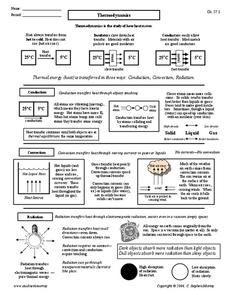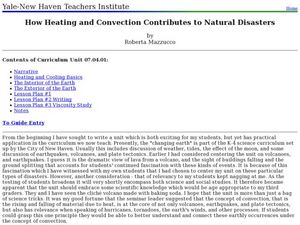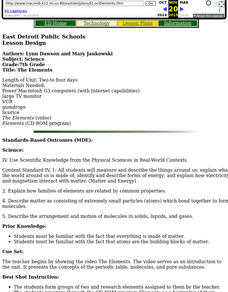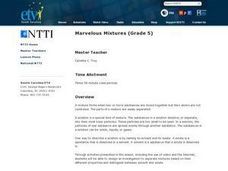Curated OER
Solution Shapes
For this solutions worksheet, students soak a pipe cleaner in hot water and a supersaturated solution of 20 Mule Team Borax. Students leave their pipe cleaner in the solution for 30 minutes and then observe. They put it back in over...
Curated OER
Activity #6 'Nothing' Matters: A Demonstration
Students observe the 'pouring' of a gas. They compare the masses (weights) and densities of two gases. Pupils define the following terms: matter, mass, and density. Students answer questions after watching the demonstration.
Curated OER
Do These Properties Matter?
Third graders rotate between three property stations, the solid station, the gas station, and the liquid station. They experiment with each activity until the teacher gives the signal to change.
Curated OER
A Simple Viscosity Test
Fourth graders experiment with the viscosity of different liquids. They use a stopwatch to time the a steel ball as it drops through different liquids.
Curated OER
Soild Waste and Recycling
In this unit of lessons, students examine solid waste and recycling. They discover the concept of decomposition. They also observe the decomposition process and make observatins.
Curated OER
Fossil Fuels: Facing the Issues
Students explore energy by researching fuel usage on Earth. In this fossil fuel lesson, students define fossil fuels, the energy created by burning them, and the impact on the environment when using them. Students conduct pollution...
BBC
Sorting and Using Materials
First and second graders see that everyday objects are made from a variety of materials. They interact with objects such as keys, plastic spoons, a wooden ruler, a towel, and a plastic bag. A discussion ensues which leads them to...
Curated OER
Molecules
Young scholars combine movement with science in this fun integrated lesson plan. When students are "liquid" they can "melt" or "ooze" at the end and when they are are "solids" they can "freeze" in a shape.
Curated OER
Quick Freeze (Demonstration)
Students witness an demonstration in which a bottle of club soda will go from a liquid to a solid when it is opened and the carbon dioxide is allowed to escape. This will help them understand that the freezing point of a solution will...
Curated OER
Thermodynamics
In this thermodynamics instructional activity, students learn about insulators and conductors. Students compare the three ways thermal energy is transferred: conduction, convection, and radiation. This instructional activity has 22...
Curated OER
Thermodynamics
In this thermodynamics worksheet, students read about conduction, convection and radiation. They answer 47 questions about heat transfer, thermal equilibrium, insulators, conductors and the states of matter.
Curated OER
Ooblek
Learners demonstrate the three states of matter. In this matter lesson, students read Bartholomew and the Ooblek. Learners create "ooblek" and discuss what state of matter it is.
Curated OER
Water and Ice
Learners perform experiments in pairs to visualize the changes in water during freezing and melting. In this properties of water instructional activity, students use their senses and inquiry tools to understand the changes in state of...
Curated OER
Matter for Minors
Students use streaming videos, web sites, and hands on activities students to explore matter. They focus on how temperature affects matter and what the particles look like in the states of matter.
Curated OER
Matter and Molecular Motion
Fourth graders define the states of matter and their properties. They demonstrate the air is matter and observe the effect of molecular motion through these activities.
Curated OER
Comparing Covalent and Ionic Substances
In this covalent and ionic substances worksheet, students use the internet to find information about the characteristics of covalent and ionic substance and explain what causes the differences in these types of substances.
Curated OER
When It Comes to Sound, I'm All Ears!
Students discover how sound is produced and how sound travels. Through inquiry, problem solving and hands-on activities, students explore high and low sounds and the mediums in which sound travels best.
Curated OER
Earthquakes
After reading an article on earthquakes and tsunamis, students answer a series of multiple choice questions about what they have learned. All answers can be found within the article, making this a good way to prepare for reading...
Curated OER
Rate of Solution Lab
In this rate of solution instructional activity, students determine how quickly a solute dissolves in a solvent by testing one independent variable such as temperature, particle size or the amount of stirring. Students design their...
Curated OER
Three Clouds Activity
Students understand how clouds are formed. In this cloud lesson, students participate in three experiments to make clouds. Students complete activity sheets for each experiment.
Curated OER
How Heating and Convection Contributes to Natural Disasters
Learners study the basics of heating and cooling and how it pertains to the earth. In this global instructional activity students read the Magic Tree House book then create a chart of their findings.
Curated OER
Cooking Up an Explanation
Young scholars pose scientific questions about food items and research their explanations. They then create recipe cards with the answers and present their findings in a cooking show format.
Curated OER
The Elements
Young scholars watch video, The Elements, research information about elements using both the Internet and CD-ROM program, and create atoms out of gumdrops and licorice.
Curated OER
Marvelous Mixtures
Fifth graders design an experiment in which they separate mixtures. In this mixtures lesson, 5th graders define mixtures, solutions, solutes, and solvents. They watch a video, complete worksheets, and perform an experiment to separate...

























